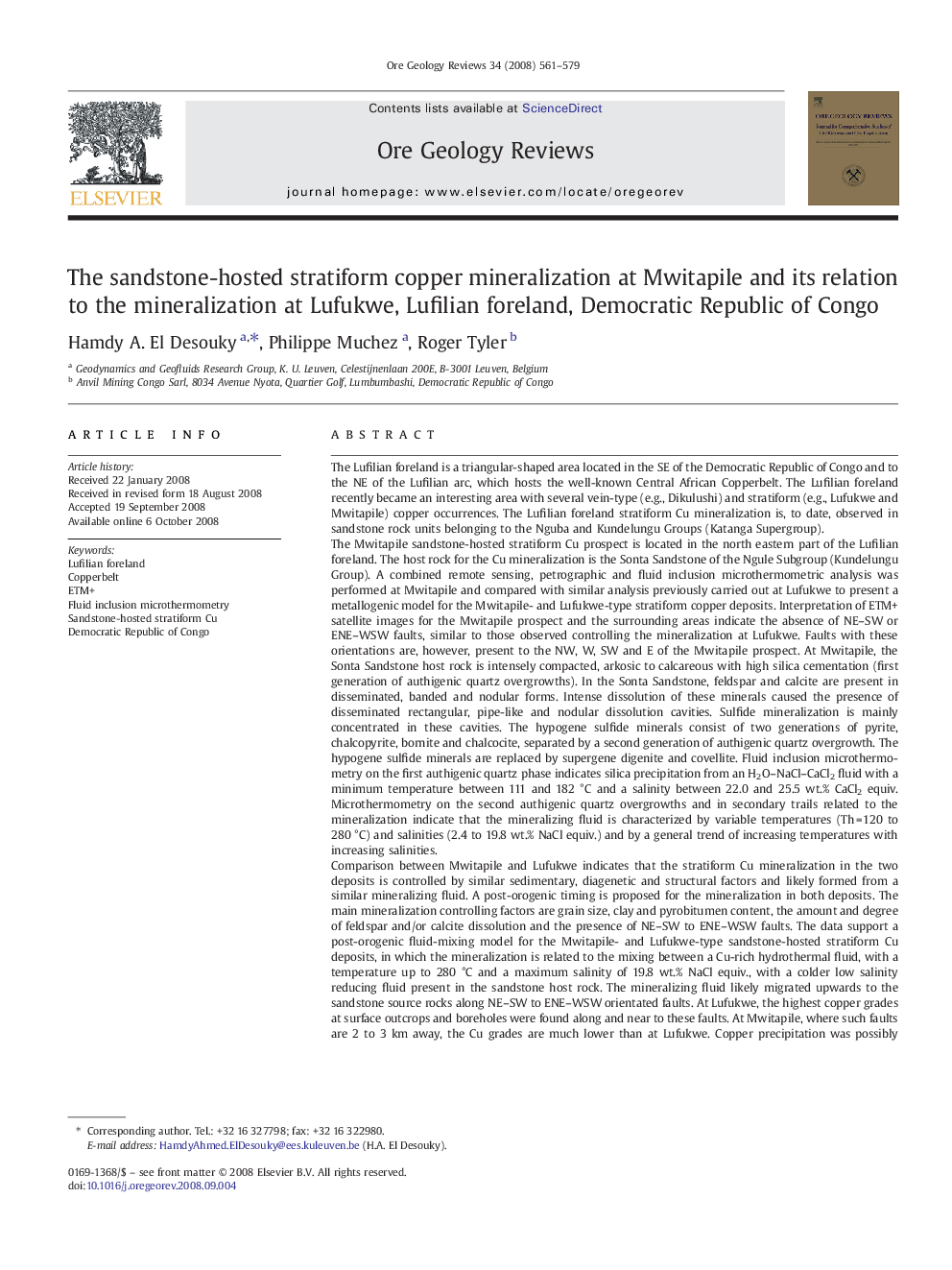| کد مقاله | کد نشریه | سال انتشار | مقاله انگلیسی | نسخه تمام متن |
|---|---|---|---|---|
| 4697993 | 1351916 | 2008 | 19 صفحه PDF | دانلود رایگان |

The Lufilian foreland is a triangular-shaped area located in the SE of the Democratic Republic of Congo and to the NE of the Lufilian arc, which hosts the well-known Central African Copperbelt. The Lufilian foreland recently became an interesting area with several vein-type (e.g., Dikulushi) and stratiform (e.g., Lufukwe and Mwitapile) copper occurrences. The Lufilian foreland stratiform Cu mineralization is, to date, observed in sandstone rock units belonging to the Nguba and Kundelungu Groups (Katanga Supergroup).The Mwitapile sandstone-hosted stratiform Cu prospect is located in the north eastern part of the Lufilian foreland. The host rock for the Cu mineralization is the Sonta Sandstone of the Ngule Subgroup (Kundelungu Group). A combined remote sensing, petrographic and fluid inclusion microthermometric analysis was performed at Mwitapile and compared with similar analysis previously carried out at Lufukwe to present a metallogenic model for the Mwitapile- and Lufukwe-type stratiform copper deposits. Interpretation of ETM+ satellite images for the Mwitapile prospect and the surrounding areas indicate the absence of NE–SW or ENE–WSW faults, similar to those observed controlling the mineralization at Lufukwe. Faults with these orientations are, however, present to the NW, W, SW and E of the Mwitapile prospect. At Mwitapile, the Sonta Sandstone host rock is intensely compacted, arkosic to calcareous with high silica cementation (first generation of authigenic quartz overgrowths). In the Sonta Sandstone, feldspar and calcite are present in disseminated, banded and nodular forms. Intense dissolution of these minerals caused the presence of disseminated rectangular, pipe-like and nodular dissolution cavities. Sulfide mineralization is mainly concentrated in these cavities. The hypogene sulfide minerals consist of two generations of pyrite, chalcopyrite, bornite and chalcocite, separated by a second generation of authigenic quartz overgrowth. The hypogene sulfide minerals are replaced by supergene digenite and covellite. Fluid inclusion microthermometry on the first authigenic quartz phase indicates silica precipitation from an H2O–NaCl–CaCl2 fluid with a minimum temperature between 111 and 182 °C and a salinity between 22.0 and 25.5 wt.% CaCl2 equiv. Microthermometry on the second authigenic quartz overgrowths and in secondary trails related to the mineralization indicate that the mineralizing fluid is characterized by variable temperatures (Th = 120 to 280 °C) and salinities (2.4 to 19.8 wt.% NaCl equiv.) and by a general trend of increasing temperatures with increasing salinities.Comparison between Mwitapile and Lufukwe indicates that the stratiform Cu mineralization in the two deposits is controlled by similar sedimentary, diagenetic and structural factors and likely formed from a similar mineralizing fluid. A post-orogenic timing is proposed for the mineralization in both deposits. The main mineralization controlling factors are grain size, clay and pyrobitumen content, the amount and degree of feldspar and/or calcite dissolution and the presence of NE–SW to ENE–WSW faults. The data support a post-orogenic fluid-mixing model for the Mwitapile- and Lufukwe-type sandstone-hosted stratiform Cu deposits, in which the mineralization is related to the mixing between a Cu-rich hydrothermal fluid, with a temperature up to 280 °C and a maximum salinity of 19.8 wt.% NaCl equiv., with a colder low salinity reducing fluid present in the sandstone host rock. The mineralizing fluid likely migrated upwards to the sandstone source rocks along NE–SW to ENE–WSW orientated faults. At Lufukwe, the highest copper grades at surface outcrops and boreholes were found along and near to these faults. At Mwitapile, where such faults are 2 to 3 km away, the Cu grades are much lower than at Lufukwe. Copper precipitation was possibly promoted by reduction from pre-existing hydrocarbons and non-copper sulfides and by the decrease in fluid salinity and temperature during mixing. Based on this research, new Cu prospects were proposed at Lufukwe and Mwitapile and a set of recommendations for further Cu exploration in the Lufilian foreland is presented.
Journal: Ore Geology Reviews - Volume 34, Issue 4, December 2008, Pages 561–579